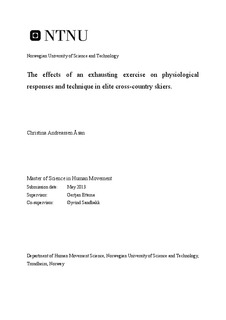| dc.description.abstract | The ability to reproduce a high energy delivery capacity and an efficient conversion of energy to work rate and speed, is essential for performance in sports with several competitions during a day, such as in cross-country skiing sprint. The purpose of this study was to investigate whether gross efficiency (GE), kinematic variables and ski kinetics during roller ski skating were influenced by an incremental exercise to exhaustion. Therefore, twelve elite male crosscountry skiers completed 4-minute submaximal stages in the G3 skating technique pre and post to an incremental test to exhaustion. There was a recovery period of 10 minutes from the finish of the incremental test until the post submaximal test to obtain steady state conditions. During the submaximal tests, physiological responses were measured by gas exchange and blood lactate, kinematic variables from a motion capture system and ski kinetics from force measurements on instrumented roller skis. Prior to the pre submaximal test and directly after the incremental test, peak power for the upper and lower limbs was assessed in concentric bench press and squat jump, in order to assess possible changes in neuromuscular capacity. The result showed a 4% increased VO2 and decreased GE (15.5±0.7% vs. 15.2±0.5%, P=0.02) at post-test. Additionally, the blood lactate concentration increased from 2.4±1.0 to 6.2±2.5 mmol L-1 (P<0.001). Cycle length decreased (8.1±0.6 m vs. 7.7±0.6 m, P<0.001) and cycle rate increased (0.49±0.04 Hz vs. 0.51±0.04 Hz, P<0.001) from pre to post test. The ski forces did not change significantly from pre- to post-test, and the peak power tests remained unchanged. In conclusion, the skiers demonstrated higher physiological stress during the submaximal post-test, with corresponding shorter cycle length and higher cycle rate. This indicates a reduced ability to produce propulsive power and an efficient technique. However, no differences were found in the applied ski forces or in upper and lower limb peak power. Thus, the differences in GE and cycle length may be related to changes in technique, such as alternations in the work done by poling or reduced force effectiveness of the push-off.
Keywords: cross-country skiing; gross efficiency; kinematic; ski kinetic | nb_NO |
